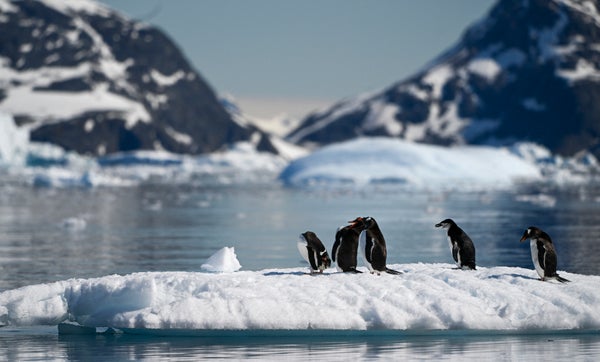August 22, 2024
3 min read
Far-Flung Trash Can Reach Remote Antarctica, Threatening the Vulnerable Ecosystem
New research suggests that remote Antarctica is more vulnerable to trash and invasive species washing up from longer distances than previously thought
A chinstrap (Pygoscelis antarcticus) and a gentoo (Pygoscelis papua) penguin.
Juan Barreto/AFP via Getty Images
CLIMATEWIRE | For much of the last century, Antarctica was widely considered a world of its own — remote, inhospitable and largely insulated from human influences and invasive species.
But that’s changing.
Tourism is bringing more humans into contact with the frozen continent. Climate change is threatening to melt away its protective shield of surrounding sea ice.
On supporting science journalism
If you’re enjoying this article, consider supporting our award-winning journalism by subscribing. By purchasing a subscription you are helping to ensure the future of impactful stories about the discoveries and ideas shaping our world today.
And now, scientists say they’ve identified another threat to Antarctica’s fragile ecosystem. New experiments suggest that floating debris can reach its icy shores from much longer distances than researchers previously believed — even as far as New Zealand or South America.
That means rafts of seaweed or clumps of plastic garbage could potentially carry new and dangerous organisms thousands of miles across the ocean to one of the world’s most vulnerable environments.
The findings, published Wednesday in the scientific journal Global Change Biology, challenge a long-held scientific belief that floating objects from other continents don’t wash up in Antarctica.
While kelp rafts or plastic debris do sometimes find their way ashore, studies have found they typically originate in the nearby sub-Antarctic islands, like South Georgia or Kerguelen islands. They never come from other continents.
But that doesn’t mean it couldn’t happen, the new study suggests.
The researchers used a special computer model to test the idea, simulating ocean currents in the Southern Hemisphere. They placed virtual particles into the simulated waters around South America, South Africa, New Zealand and Australia, and other smaller islands throughout the ocean to see where they would wash up.
The simulations suggest that it’s possible for floating debris to make it to Antarctica from just about anywhere — although some origin locations have better odds than others.
Unsurprisingly, the sub-Antarctic islands contributed the most debris to Antarctica’s shores in the simulations. Scientists already knew that from real-life observations. But they found it was technically possible for particles to make it all the way from New Zealand, Australia, South America and South Africa — even if it took several years for them to get there.
New Zealand had the best odds of all the larger land masses. Australia and South Africa had the worst — although their chances still weren’t impossible.
For now, it’s just a modeling study. The results haven’t yet been proven in real-life observations.
But the findings do suggest that floating objects already could be washing up in Antarctica from far-flung locales, even if scientists haven’t yet discovered them. And if invasive species happen to hitch a ride, they could pose a major threat to the delicate ecosystems there. Many of Antarctica’s native species are highly adapted to their local environment, and they’re found nowhere else in the world.
These threats may grow more dangerous in the coming decades as climate change and other human influences weaken Antarctica’s natural defenses. The risk of invasive species is increasing as more ships travel to the remote reaches of the Southern Ocean, driven by a burgeoning Antarctic tourism industry. Ships can easily carry nonnative species from all over the world.
Antarctica’s sea ice also has suddenly declined in recent years — and while scientists still aren’t sure why, climate change may be one of the drivers. Sea ice acts as a shield between the Antarctic continent and the rest of the ocean, helping to keep invaders at bay. As the ice dwindles, it increases the odds of floating debris washing up on shore.
“Sea ice is very abrasive and so acts as a barrier for many non-native species to successfully establish around Antarctica,” said lead study author Hannah Dawson, a scientist at the University of Tasmania, in a statement. “If the recent decline in Antarctic sea ice continues, then living things floating at the surface, or attached to floating objects, could have an easier time colonizing the continent, which may have big impacts on ecosystems.”
Reprinted from E&E News with permission from POLITICO, LLC. Copyright 2024. E&E News provides essential news for energy and environment professionals.

